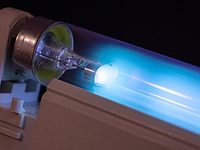Chalk-Based Fabric Coating Cools the Air Beneath It by 8 °F

In the heat of summer, those who spend time outdoors — whether athletes, landscapers, or beachgoers — could greatly benefit from fabrics that help keep them cool. While some existing textiles can reflect sunlight or dissipate body heat, they often rely on specialized fibers or complex manufacturing techniques. Now, researchers have developed a durable, chalk-based coating that can cool the air beneath treated fabrics by up to 8 °F.
This new coating will be presented by Evan D. Patamia, a graduate student at the University of Massachusetts Amherst, at the American Chemical Society’s Fall 2024 meeting. The event, held both virtually and in person from August 18-22, featured around 10,000 presentations on various scientific topics.
Video courtesy of The American Chemical Society.
As explained by Trisha L. Andrew, a chemist and materials scientist working with Patamia, the human body and clothing absorb ultraviolet (UV) and near-infrared (near-IR) light from the sun, causing us to heat up. To combat this, scientists have been developing textiles that reflect sunlight and release body heat, a process known as radiative cooling. Some of these materials incorporate synthetic particles like titanium dioxide or aluminum oxide into fibers, while others use organic polymers that require environmentally harmful chemicals.
Looking for a more sustainable solution, Andrew and her team sought to create a textile coating using natural or eco-friendly materials. Drawing inspiration from limestone-based plasters traditionally used to cool homes in sunny regions, Patamia and fellow researcher Megan K. Yee devised a method to integrate calcium carbonate (the main component in chalk) and barium sulfate into a polymer layer applied via chemical vapor deposition (CVD).
The team tested the cooling performance of treated versus untreated fabrics on a hot, sunny day when temperatures exceeded 90 °F. The air beneath the treated fabric was up to 8°F cooler than the ambient temperature, and up to 15°F cooler than under untreated fabric. This confirmed the coating’s effectiveness in providing a cooling sensation similar to standing in the shade.
Yee also tested the durability of the coating, simulating the friction and impact of washing. The results showed that the coating remained intact and retained its cooling properties after washing.
Although current processes are limited by lab equipment size, Andrew is involved in a startup aiming to scale up the CVD process for larger fabric production. This innovation could potentially be commercialized, offering a new way to keep people cool in extreme heat using eco-friendly methods.
The research received funding from the U.S. National Science Foundation, and Andrew is exploring commercial opportunities for the polymer coating process. More details on the research will be available in the presentation titled “Functional reflective textile coatings for personal cooling” at the ACS Fall 2024 meeting.
The original story was published online through the ACS here: https://www.acs.org/pressroom/presspacs/2024/august/chalk-based-coating-creates-a-cooling-fabric.html.
The research was presented at a meeting of the American Chemical Society. ACS does not conduct research, but publishes and publicizes peer-reviewed scientific studies.
Looking for a reprint of this article?
From high-res PDFs to custom plaques, order your copy today!








